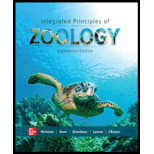
Explain each of these properties of water, and describe how each is conferred by the dipolar nature of a water molecule: high specific heat capacity; high heat of vaporization; unique density behavior; high surface tension; capacity to be a good solvent for ions of salts.
To explain: The properties of water including high specific heat capacity, the high heat of vaporization, high surface tension, a good solvent for ions and unique density and also how these properties are conferred by the dipolar nature of a molecule of water.
Introduction: Water is very important for maintaining life on earth. It is the most abundant compound. It forms 70% of a living individual.
Explanation of Solution
Water consists of several unique properties. These properties play an essential role in the living world. Hydrogen bonds are present between two adjacent molecules of water that underlie all these properties.
- High specific heat capacity- To increase the temperature of 1 g of water to 1°C, 1 calorie is needed. Water has the highest thermal capacity than other liquid. This energy is used for breaking hydrogen bonds and increases kinetic energy.
- High heat of vaporization- To convert 1g of water to vapor, it requires more than 500 calories. Hence, water has a high heat of vaporization.
- Unique density behavior- Water has a unique density behavior when there is a change in temperature. Most of the liquid forms become denser when the temperature decreases. However, water is the only one who reaches its maximum point of density, that is, at 4°C and can still remain a liquid.
- High surface tension- Water has exceeding surface tension than any liquid except mercury. Cohesiveness produces by hydrogen bonding is important for regulating protoplasmic form, which results in creating an ecological niche for insects.
- Good solvent- Water is a very good solvent. The dipolar nature of water created this property. It causes water molecules to revolve around charged ions.
Solvents that lack dipolar nature are less effective in keeping the ions separated.
Want to see more full solutions like this?
Chapter 2 Solutions
Loose Leaf For Integrated Principles Of Zoology
- What is the structure and function of Eukaryotic cells, including their organelles? How are Eukaryotic cells different than Prokaryotic cells, in terms of evolution which form of the cell might have came first? How do Eukaryotic cells become malignant (cancerous)?arrow_forwardWhat are the roles of DNA and proteins inside of the cell? What are the building blocks or molecular components of the DNA and proteins? How are proteins produced within the cell? What connection is there between DNA, proteins, and the cell cycle? What is the relationship between DNA, proteins, and Cancer?arrow_forwardWhy cells go through various types of cell division and how eukaryotic cells control cell growth through the cell cycle control system?arrow_forward
- In one paragraph show how atoms and they're structure are related to the structure of dna and proteins. Talk about what atoms are. what they're made of, why chemical bonding is important to DNA?arrow_forwardWhat are the structure and properties of atoms and chemical bonds (especially how they relate to DNA and proteins).arrow_forwardThe Sentinel Cell: Nature’s Answer to Cancer?arrow_forward
- Molecular Biology Question You are working to characterize a novel protein in mice. Analysis shows that high levels of the primary transcript that codes for this protein are found in tissue from the brain, muscle, liver, and pancreas. However, an antibody that recognizes the C-terminal portion of the protein indicates that the protein is present in brain, muscle, and liver, but not in the pancreas. What is the most likely explanation for this result?arrow_forwardMolecular Biology Explain/discuss how “slow stop” and “quick/fast stop” mutants wereused to identify different protein involved in DNA replication in E. coli.arrow_forwardMolecular Biology Question A gene that codes for a protein was removed from a eukaryotic cell and inserted into a prokaryotic cell. Although the gene was successfully transcribed and translated, it produced a different protein than it produced in the eukaryotic cell. What is the most likely explanation?arrow_forward
 Human Biology (MindTap Course List)BiologyISBN:9781305112100Author:Cecie Starr, Beverly McMillanPublisher:Cengage Learning
Human Biology (MindTap Course List)BiologyISBN:9781305112100Author:Cecie Starr, Beverly McMillanPublisher:Cengage Learning Concepts of BiologyBiologyISBN:9781938168116Author:Samantha Fowler, Rebecca Roush, James WisePublisher:OpenStax College
Concepts of BiologyBiologyISBN:9781938168116Author:Samantha Fowler, Rebecca Roush, James WisePublisher:OpenStax College
 Biology (MindTap Course List)BiologyISBN:9781337392938Author:Eldra Solomon, Charles Martin, Diana W. Martin, Linda R. BergPublisher:Cengage Learning
Biology (MindTap Course List)BiologyISBN:9781337392938Author:Eldra Solomon, Charles Martin, Diana W. Martin, Linda R. BergPublisher:Cengage Learning Biology Today and Tomorrow without Physiology (Mi...BiologyISBN:9781305117396Author:Cecie Starr, Christine Evers, Lisa StarrPublisher:Cengage Learning
Biology Today and Tomorrow without Physiology (Mi...BiologyISBN:9781305117396Author:Cecie Starr, Christine Evers, Lisa StarrPublisher:Cengage Learning





